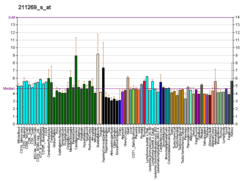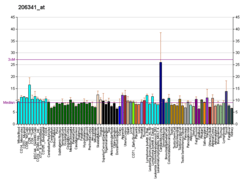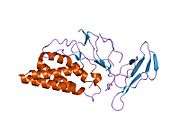IL2RA
Interleukin-2 receptor alpha chain (also called CD25) is a protein that in humans is encoded by the IL2RA gene.[5]
The interleukin 2 (IL2) receptor alpha (IL2RA) and beta (IL2RB) chains, together with the common gamma chain (IL2RG), constitute the high-affinity IL2 receptor. Homodimeric alpha chains (IL2RA) result in low-affinity receptor, while homodimeric beta (IL2RB) chains produce a medium-affinity receptor. Normally an integral-membrane protein, soluble IL2RA has been isolated and determined to result from extracellular proteolysis. Alternately-spliced IL2RA mRNAs have been isolated, but the significance of each is currently unknown.[6]
Description
It is a type I transmembrane protein present on activated T cells, activated B cells, some thymocytes, myeloid precursors, and oligodendrocytes. Though IL2RA has been used as a marker to identify CD4+FoxP3+ regulatory T cells in mice, it has been found that a large proportion of resting memory T cells constitutively express IL2RA in humans.[7]
IL2RA is expressed in most B-cell neoplasms, some acute nonlymphocytic leukemias, neuroblastomas, mastocytosis and tumor infiltrating lymphocytes. It functions as the receptor for HTLV-1 and is consequently expressed on neoplastic cells in adult T cell lymphoma/leukemia. Its soluble form, called sIL-2R may be elevated in these diseases and is occasionally used to track disease progression.
Clinical significance
Chagas disease
Infection by the protozoan Trypanosoma cruzi causes Chagas disease, characterized by a reduction in the amount of IL2RA expressed on the surface of immune cells. This leads to chronic immune suppression, becoming increasingly severe over the course of many years and ultimately resulting in death if left untreated.
Multiple sclerosis
The multiple sclerosis drug daclizumab binds to and blocks IL2RA.[8]
References
- GRCh38: Ensembl release 89: ENSG00000134460 - Ensembl, May 2017
- GRCm38: Ensembl release 89: ENSMUSG00000026770 - Ensembl, May 2017
- "Human PubMed Reference:". National Center for Biotechnology Information, U.S. National Library of Medicine.
- "Mouse PubMed Reference:". National Center for Biotechnology Information, U.S. National Library of Medicine.
- Leonard WJ, Donlon TA, Lebo RV, Greene WC (Aug 1985). "Localization of the gene encoding the human interleukin-2 receptor on chromosome 10". Science. 228 (4707): 1547–9. doi:10.1126/science.3925551. PMID 3925551.
- "Entrez Gene: IL2RA interleukin 2 receptor, alpha".
- Triplett, Todd A.; et al. (July 2012). "Defining a functionally distinct subset of human memory CD4+ T cells that are CD25POS and FOXP3NEG". European Journal of Immunology. 42 (7): 1893. doi:10.1002/eji.201242444. PMID 22585674.
- "Zinbryta Summary of Product Characteristics" (PDF). European Medicines Agency. 2016.
Further reading
- Kuziel WA, Greene WC (June 1990). "Interleukin-2 and the IL-2 receptor: new insights into structure and function". J. Invest. Dermatol. 94 (6 Suppl): 27S–32S. doi:10.1111/1523-1747.ep12875017. PMID 1693645.
- Waldmann TA (February 1991). "The interleukin-2 receptor". J. Biol. Chem. 266 (5): 2681–4. PMID 1993646. Retrieved 2008-08-04.
- Vincenti F (September 2004). "Interleukin-2 receptor antagonists and aggressive steroid minimization strategies for kidney transplant patients". Transpl. Int. 17 (8): 395–401. doi:10.1007/s00147-004-0750-3. PMID 15365604.
External links
- Mouse CD Antigen Chart
- Human CD Antigen Chart
- CD4+FoxP3+ regulatory T cells gradually accumulate in gliomas during tumor growth and efficiently suppress antiglioma immune responses in vivo
- Overview of all the structural information available in the PDB for UniProt: P01589 (Interleukin-2 receptor subunit alpha) at the PDBe-KB.









